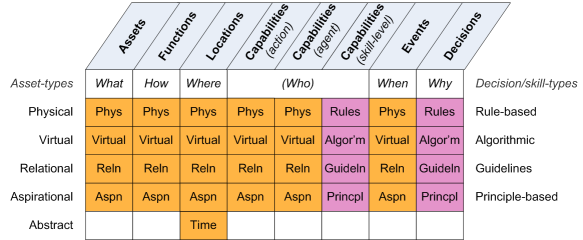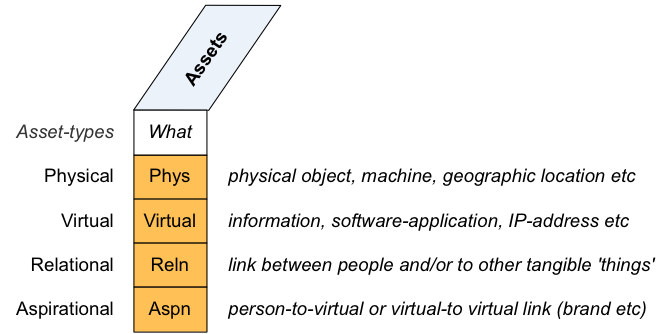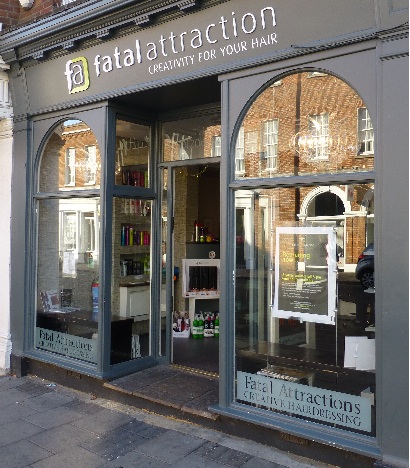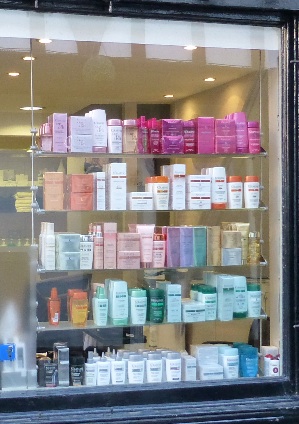Services and Enterprise Canvas review – worked-example
What is a service-oriented architecture – particularly at a whole-of-enterprise scope? How best could we describe that architecture?
We’ve explored those questions in some depth in the preceding series of posts. It’s left us with a set of visual-checklists, including the main Enterprise Canvas model-type:
…the service-content checklist:
…and, for specific detail in Exchanges between services, the asset-dimensions checklist:
But how does all of this come together, in everyday enterprise-architecture practice? For a worked-example, let’s use this question from Anders Danielsson, in a comment to the Investors post in the series:
I know that the relationship is the asset, but how about when the “asset” being “worked” upon is a person (let’s say at the hairdresser or )? Where in the single-row extended-Zachman would this hairdresser customer go? If it is a relational asset, which relation are we looking at here?
Let’s do this worked-example as a fictional story, with some aside-notes to explain specific points in terms of those visual-checklists above. Imagine, then, that there’s a hairdresser’s called Mane Attraction (with mild apologies to the real salon shown below):
“Darling! Come on in!” That booming voice greets Deirdre Thorn as she opens the door into Mane Attraction. The voice, of course, belongs to the main attraction himself, Benjamin Court (“always Benjamin, dear, Benj or Benjy if you must, never the pedestrian Ben!”), holding court in his stylishly-up-market salon in this somewhat dowdy and down-at-heel town, as he has done these past twenty years.
(You’ll notice straight away in that photo above that we’d start with the most-visible and mainly-physical Asset – the shop – in context of the street and town. Within that Asset there are many other physical-Assets, such as the displays and, further in the chairs and basins, and all the equipment and products needed for hair-care. What’s perhaps not so obvious are the relational-Assets – Deirdre and Benjamin have known each other for some while, and likewise his in-person business-connections with other clientele – and also the aspirational-Assets (as reputation-assets) from having run a salon in the same place for that length of time.)
He seats her in the chair, in front of the large mirror. In its reflection she sees Benjamin, still trim, energetic, demonstrative in movement, his long-established goatee sharpened almost to a point to counter and contrast his own now-somewhat-thinner hair; and herself, still looking pretty good in her mid-fifties, that’s true, if undeniably tired right now, and yes, admit it, showing some signs of the toll of the daily wear and tear. She sighs.
(All of these we could perhaps describe assets of the respective person, but note that none of these make the respective person an ‘asset’ – an important difference! Note too the implicit equivalents of CRUD – Create, Read, Update, Delete – in Deirdre’s quick status-update on those assets, both of of hers and of Benjamin’s.)
He runs his hands over and through her hair, drawing her attention to its reflection in the mirror. “What’s on your calendar this week, my love? What’s our good excuse for shining you up to your brightest and best?”
(In Enterprise Canvas terms, this is Benjamin establishing part of the Value-Proposition for the services to be delivered, linked through via Customer-Relations.)
“It’s my grand-daughter’s birthday – all the family will be coming over for that.”
(Her response via her Supplier-Relations – since Benjamin is the Supplier, in this context. A connection is now established across that flow: though note that in essence it’s all non-tangible – aspirational (shared-intent), relational (the person-to-person link between them), virtual (ideas and information) – all of it in fast Read/Update asset-cycles that are almost too fast to see.)
“Ooh, right! – we really must do something special for that, mustn’t we? Better get out the bible, then.” And he reaches out to the low table in the waiting-area behind him, to pick up not one of the glossy magazines, but a thick portfolio-binder full of hairstyles – pictures of models, yes, though not the ‘shiny-young-things’ in the fashion magazines, but women noticeably closer to Deirdre’s age.
(Note the connection to the Value-Proposition – namely that the styling is appropriate for the client’s needs, such as age, culture and the like. Value-proposition is not a ‘feature’, “a fancy name for product or service”, but much more about connection to a shared-story.)
They flick through the pages, talk for while, throw ideas back and forth, until Benjamin stops with an emphatic “Yes!”, closes the book. “That’s what we’ll do!”
(That’s the Event that triggers the move from the ‘before’ stage of service-delivery to the ‘during’ phase. Remember that service-architecture is recursive – smaller segments of service-delivery within the overall scope, each with their own respective ‘before’, ‘during’ and ‘after’ – but for Deirdre’s overall visit to the salon, this is a key transition that we ought to note.)
“Trace, darling, here a moment, if you would? Tints, we want to do highlight-tints, which ones would you say are best for Mrs T?”
Trace Mills (“never Tracy, thank you, just Trace”) comes out from the back of the salon area, where’s she’s been sitting quietly in front of the computer. As soon as Deirdre had come through the door, Trace discreetly opened her record in the salon’s database. Trace is rather proud of this system: she adapted it herself from a medical-records package, and it allows her to keep track of much more information about hair-type, products used, techniques applied and so on – more like a medical history than a standard salon ‘customer relations’ app. Hairdresser-geek? passionate about everything to do with hair and hair-care? – yeah, that’s Trace all right!
(I’ve occasionally been accused of being ‘anti-IT’, for the sin of failing to place IT at the front and centre of everything. But that charge is just not true: as I’ve actually said many times, some form of information-technology will and must always have a key place in every enterprise. The trick, as in this case, is in finding the right place for it, with the right information managed in the right way – a point that Trace here clearly understands well.)
In the background, she’s been listening to the conversation between Deirdre and Benjamin, and had already chosen a recommended brand from the four they have in stock, even before the tint was mentioned. She comes over to join them, mentions the brand-name. “Thank you, Trace, darling – cerise, if you would?” is Benjamin’s reply. She goes out to the stockroom to get it for him, then goes back to her computer to update Deirdre’s record.
(Perhaps the key point to note here is the two services working in parallel: Benjamin as ‘front of house’ doing the actual service-delivery from the client’s perspective – Customer-Channels – with Trace doing Value-Creation in ‘back of house’. Notice that the service-interfaces between those two ‘child-services’ have been running continuously in the background throughout the session – mostly in the form of implicit information, small cues built up between Benjamin and Trace over a decade of working together.)
Benjamin settles down to working on Deirdre’s hair, doing the trim, setting up for the tint, wrapping the result in small strips of tinfoil, all the while keeping up a near-constant background conversation about what’s going on in each others’ lives.
(Each of these activities is a service-delivery in its own right, each requiring their own Functions, Capabilities, Events and Decisions – though the Location is essentially the same for all of them, of course. There are at least three distinct Assets being worked on here, of which the first and most obvious one is Deirdre’s hair. The second, which we’ve noted before, is the relationship between Deirdre and Benjamin – a relational-Asset. And the third is Deirdre’s sense of her own self – an aspirational-Asset, in this context also linked to the shared-vision around hair and beauty, and thence in turn to the Value-Proposition presented by the salon. There’s also a separate relational-Asset between Deirdre and Trace, though it’s somewhat downplayed in this specific interaction.)
It’s done.
(A simple yet important point, though often easy to miss: this is the Event that marks the end of the main part of service-delivery, and the transition into the wrap-up phases of service-cycle.)
“Will it wash out on the first wash?” asks Deirdre. “Oh, no”, says Benjamin, “but you might need a different shampoo. What are you using now?” She tells him. “Ah. It’s good, darling, but it might be better to use something a bit different for this. Something to give your hair a teensy bit more body, too.” Trace comes up, names a couple of brands that she’d recommend, points to the display in the window:
Benjamin grins. “Trace swears by those ones, darling; she swears at most of the others.” Trace cuts in: “We have all of those in stock, of course, but you should also be able get them at Superdrug if you’re passing there anyway.”
(Note how there’s an intentional avoidance of ‘up-selling’ or ‘cross-selling’ – the cross-sell of the shampoo actually arises on its own from Deirdre’s query, following the implicit logic of the shared-vision and the Value-Proposition. Note too how it’s made explicit that the salon’s Value-Proposition is not based primarily on price: Superdrug sells toiletries such as shampoo at lower prices than the salon could. The salon might lose the add-on sale, but gains trust – fundamental for the relational-assets and aspirational-assets – in reaffirmation that the customer’s long-term needs (actually everyone’s needs) are more important than the salon’s short-term financial profit.)
Deirdre takes the recommended shampoo, and goes to the counter to pay.
(From Deirdre’s side, a reaffirmation that, for her too, price alone is not the central point in her view of the Value-Proposition.)
“Oh, one other thing”, she says, “do you do manicures?”. “No, darling, not yet”, is the reply, “but we’ve heard a lot of good things about In Your Hands, halfway down Market Street. Do give them our love!”
(A really straightforward example here of how a shared-vision across a business-domain – health and beauty, in this case – can be used to set up what is, in effect, the creation and transfer of an aspirational-asset from Mane Attraction to In Your Hands, and thence the subsequent creation of a relational-asset between Deirdre and the manicurist. The same mechanism is in play when a customer moves from one branch of a store to another, or even moves between salesfolk in the same store: the anchor for the aspirational-asset there is to the brand, or to the reputation of the store-chain as a whole.)
Trace holds the door open for Deirdre, as she leaves with a smile on her face, and a lightness in her heart. “Come see us again soon, darling! – tell us how the party goes!” booms Benjamin from the far side of the salon. And yes, she will, of course. Like family, being here.
Practical implications
Yes, there’s a lot of detail there, much of which is easy to miss unless we pay close attention to what’s actually going on even in an everyday example such as this.
Again, the key Assets being acted on in this example:
- Deirdre’s hair (or, to be pedantic, the hair associated with Deirdre – accessible only via relational-asset link)
- the person-to-person relationship between Deirdre and Benjamin (in CRUD terms, Read, Update and Refresh)
- the person-to-person relationship between Deirdre and Trace (again, Read, Update and Refresh)
- the person-to-story aspirational-relationships between each of Deirdre, Benjamin and Trace and the overall shared-vision/story of ‘health and beauty’, which also act as the anchor for mutual-trust
There are all manner of other Assets in use in the context – chair, scissors, tint, computer, information-assets, shampoo, the salon-space itself – which are, yes, essential to the service-delivery, as Capabilities to support service-delivery. Yet if we mistake those more-visible Assets for the core of the service-delivery itself, we’re probably missing the point.
Hope this is useful, anyway?





Leave a Reply